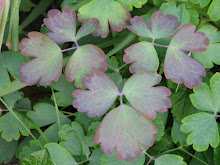South Carolina hasn't been as humid as Indianapolis, but it's just as hot. Last week, when some cool weather blew in, I felt too distracted to focus on my work. I remembered one of my favorite things to do in Indianapolis - take my camera and sit on the edge of a flower bed, just observing insect behavior and getting a few shots. It's incredibly relaxing and peaceful, and I'd often lose track of time. I haven't done that yet in South Carolina, but the mild temperatures drew me outside.
It was a real treasure trove of activity (don't forget to click on pictures for larger view)! I first found a picture-winged fly (
Delphinia picta) on the front porch. I've always called them 'anteater flies' because of their long snouts. Don't they have beautiful wings?
I saw, too, my second green lacewing larva of the season, carting around a disguising load of fluff to help it surprise unsuspecting prey. Without it, it looks a bit like those mind-controlling slugs in
Star Trek: Wrath of Khan - the ceti eel larvae. I was tickled to read that a retired entomologist for New Hampshire said of the larvae, "If they were the size of dogs, all humanity would be in trouble," referring to their famed ferocity.
Green lacewing larva:
link here
Wrath of Khan slug:
link here and
here
Am I the only one who sees it? :)
A wasp, resting on a leaf:
Oh, how I love leafhoppers! I know they're pests, but...
...aren't they beautiful? Here's a striped one:
I was really pleased to get a shot of one excreting honeydew.
Ants love to harvest this for food, since it's so sugar-rich...hence the name
honeydew.
A little beetle, buried in the lantana, gets some food of his own:
I was happy to see this little iridescent fly. It's a long-legged fly of the
Condylostylus family. They're great to have in the garden, because they eat many pests.
A common bee...
...and a little 'sweat bee' in my daisies. I've been stung by these little guys more times than I can count!
Being close to water means we see a fair amount of dragonflies. They're not easy to catch sitting still, though!
I loved watching this skipper butterfly:
They're rather shaggy for butterflies. Look closely to see how 'furry' they are!
I spent some time looking around our flowering bushes, like the Rose of Sharon.
I actually prefer the fading flower, because it turns the most beautiful shade of light blue.
Look closer...there's a bee hiding in there! Actually, the bee was dead - proboscis out and all. I've read that wild animals, knowing that they're dying, often seek out a quiet, sheltered place to wait. This seems to hold true for bees, too.
Look at those full pollen packs!
I also stumbled across a newly-dead cicada, who didn't mind a bit as I posed him for a few shots.
Those 3 red dots on the forehead are actually additional eyes called ocelli, which means
little eyes in Latin. If you like cicadas, you should watch this quick video (link
HERE) that someone sent me. It's amazing and gives you an even greater appreciation of these little guys!
Keep an eye out the next time you're near some flowers or shrubbery - who knows
what you'll spot!
Have a great week!
























































